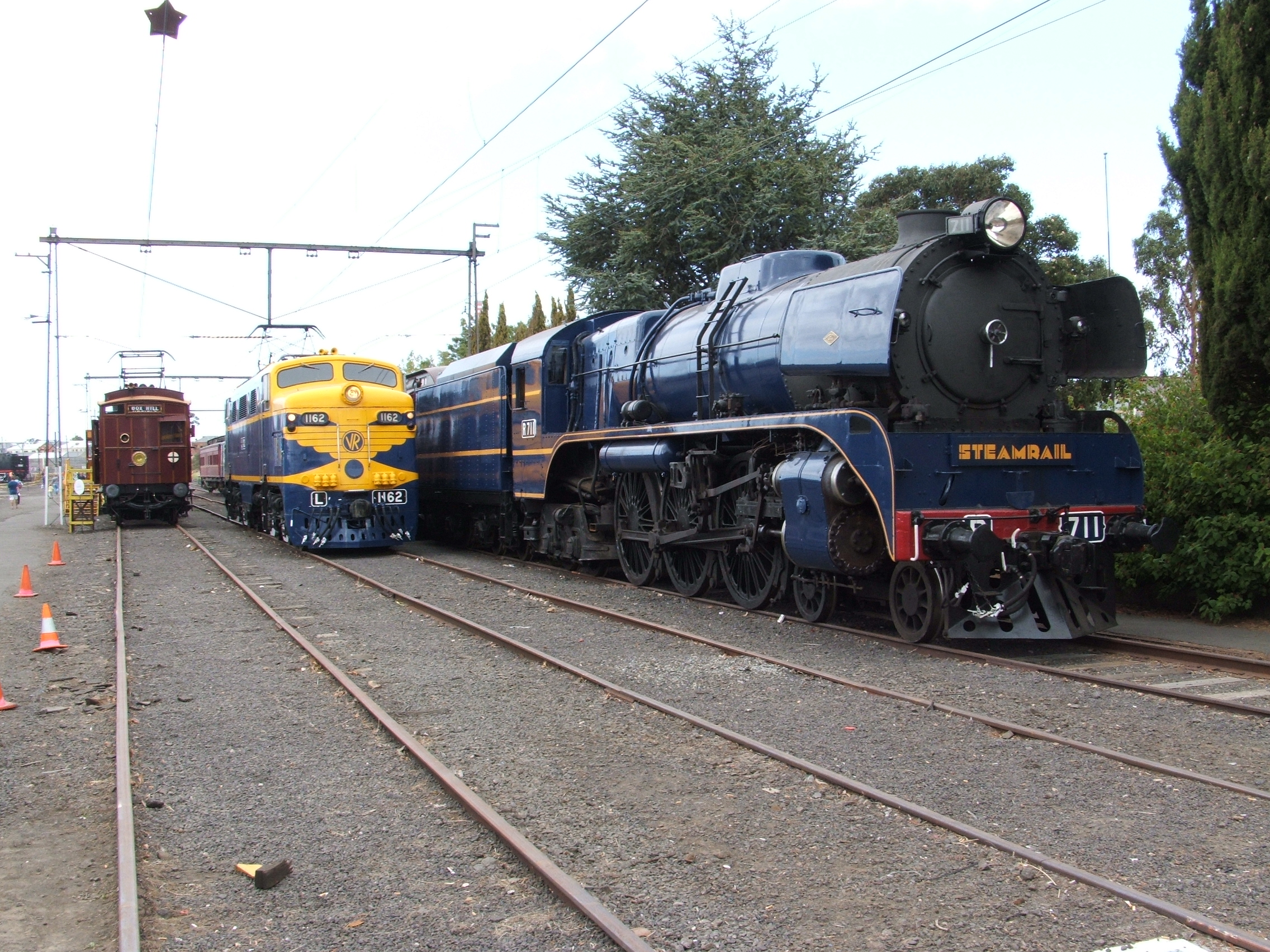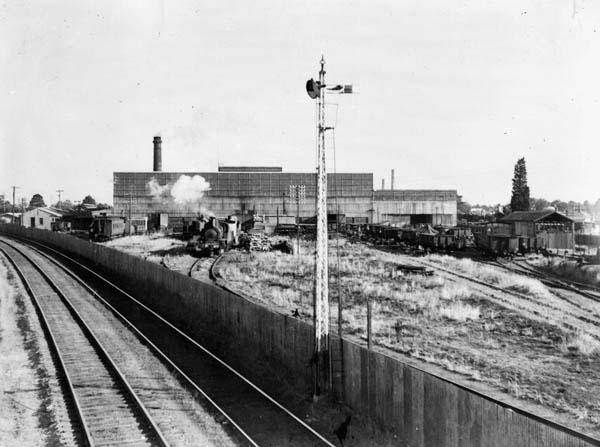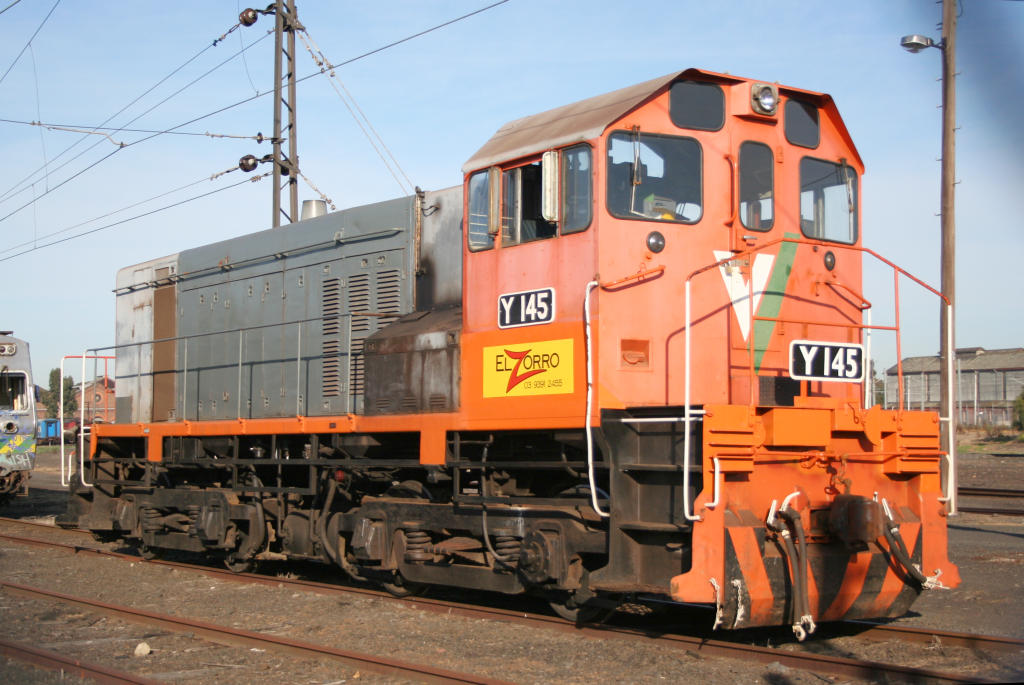|
Victorian Railways K Class
The K class was a branch line steam locomotive that ran on Victorian Railways in Australia from 1922 to 1979. Although its design was entirely conventional and its specifications unremarkable, the K class was in practice a remarkably versatile and dependable locomotive. It went on to outlast every other class of steam locomotive in regular service on the VR, and no fewer than 21 examples of the 53 originally built have survived into preservation. History The K class was the first design from the VR Locomotive Design Section under the stewardship of Alfred E Smith as Chief Mechanical Engineer. The Locomotive Design Section had introduced successful mainline and branchline passenger locomotives with the A2 class and Dd class 4-6-0s, and had recently improved mainline goods services with the C class 2-8-0. They now turned their attention to a requirement for a more powerful branchline goods locomotive, and in 1922 produced a lighter 2-8-0 "Consolidation" locomotive with ... [...More Info...] [...Related Items...] OR: [Wikipedia] [Google] [Baidu] |
Steamrail Victoria
Steamrail Victoria is a not-for-profit volunteer group established in 1965 to restore and operate historic locomotives and rolling stock used on the railways in Victoria, Australia. The main depot of the group is at the Newport Workshops ('West Block') in suburban Melbourne. In addition to operating railfan special trains and charters for private groups, the group also operates special steam trains in the Melbourne suburban area. Steamrail regularly tours the state, including participation in annual events such as the Ballarat Heritage Weekend (steam locomotive Y112 is used to shuttle between Ballarat and Sulky Gully/ Lal Lal). Steamrail Victoria also leases diesel locomotives to freight operators such as Southern Shorthaul Railroad (SSR) & Qube Logistics as required. Locomotives were also hired to El Zorro until they ceased trading. The group has custody of a number of Victorian Railways steam locomotives, including the R, D3 and K classes; in addition to several diesel ... [...More Info...] [...Related Items...] OR: [Wikipedia] [Google] [Baidu] |
2-8-0
Under the Whyte notation for the classification of steam locomotives, represents the wheel arrangement of two leading wheels on one axle, usually in a leading truck, eight powered and coupled driving wheels on four axles, and no trailing wheels. In the United States and elsewhere, this wheel arrangement is commonly known as a Consolidation, after the Lehigh and Mahanoy Railroad’s ''Consolidation'', the name of the first 2-8-0.White, John H. Jr. (1968). ''A history of the American locomotive; its development: 1830-1880''. New York: Dover Publications, p. 65. The notation 2-8-0T indicates a tank locomotive of this wheel arrangement, the "T" suffix indicating a locomotive on which the water is carried in side-tanks mounted on the engine rather than in an attached tender. The Consolidation represented a notable advance in locomotive power. After 1875, it became "the most popular type of freight locomotive in the United States and was built in greater quantities than any ot ... [...More Info...] [...Related Items...] OR: [Wikipedia] [Google] [Baidu] |
Victorian Railways J Class (1954)
The Victorian Railways J class was a branch line steam locomotive operated by the Victorian Railways (VR) between 1954 and 1972. A development of the successful Victorian Railways K class 2-8-0, it was the last new class of steam locomotive introduced on the VR. Introduced almost concurrently with the diesel-electric locomotives that ultimately superseded them, the locomotives were only in service for a relatively short time. History During the early 1950s, the Victorian Railways (VR) embarked on a massive upgrading of its ageing locomotive fleet as part of Operation Phoenix, an £80 million program to rebuild a network badly run down by years of underinvestment during the Great Depression, and the heavy workload imposed by World War II. Victoria's branch line railway network, laid with rail and featuring gradients of up to 1 in 30 (3.33 %), was still largely served by the D1, D2 and D3 variants of the once 261-strong 1902-era Dd class 4-6-0 which, by the early 1950s, were ... [...More Info...] [...Related Items...] OR: [Wikipedia] [Google] [Baidu] |
A VLine Trains Passes A Steam Locomotive At Pakenham
A, or a, is the first letter and the first vowel of the Latin alphabet, used in the modern English alphabet, the alphabets of other western European languages and others worldwide. Its name in English is ''a'' (pronounced ), plural ''aes''. It is similar in shape to the Ancient Greek letter alpha, from which it derives. The uppercase version consists of the two slanting sides of a triangle, crossed in the middle by a horizontal bar. The lowercase version can be written in two forms: the double-storey a and single-storey ɑ. The latter is commonly used in handwriting and fonts based on it, especially fonts intended to be read by children, and is also found in italic type. In English grammar, " a", and its variant " an", are indefinite articles. History The earliest certain ancestor of "A" is aleph (also written 'aleph), the first letter of the Phoenician alphabet, which consisted entirely of consonants (for that reason, it is also called an abjad to distinguish it f ... [...More Info...] [...Related Items...] OR: [Wikipedia] [Google] [Baidu] |
Newport Railway Museum
The Newport Railway Museum is located on Champion Road, Newport, Victoria, near the North Williamstown station. History The museum opened on 10 November 1962, after the Australian Railway Historical Society (ARHS) Victorian Division was allocated space at Newport Workshops by the Victorian Railways to develop a collection of key examples of steam locomotives that were then in the process of being replaced by diesel and electric locomotives. By the late 1980s, the early diesel and electric locomotives that had replaced steam traction were themselves nearing end of life, and the museum expanded its collection to incorporate a number of key examples. Following a safety audit by VicTrack, the landlord and owner of most of the exhibits, the museum closed in February 2010. After various improvements, it reopened in March 2014. On 16 June 2020, it was announced that the ARHS had withdrawn from the operation of the museum and a new group, Newport Railway Museum Inc., formed by museum ... [...More Info...] [...Related Items...] OR: [Wikipedia] [Google] [Baidu] |
K160 At Castlemaine
K16 may refer to: Aviation ;Aircraft * Junkers K 16, a German airline * Kelsey K-16, an American glider ;Airports * Becks Grove Airport, in Oneida County, New York * Seoul Air Base, designated as K-16 by the United States Air Force Other uses * K–16, an American education movement * K-16 (Kansas highway) * Dasan Machineries K16, a South Korean submachine gun * , K-class submarine of the Royal Navy * Keratin 16 Keratin 16 is a protein that in humans is encoded by the ''KRT16'' gene. Keratin 16 is a type I cytokeratin. It is paired with keratin 6 in a number of epithelial tissues, including nail bed, esophagus, tongue, and hair follicle The hair fol ... * Symphony No. 1 (Mozart), by Wolfgang Amadeus Mozart {{Letter-NumberCombDisambig ... [...More Info...] [...Related Items...] OR: [Wikipedia] [Google] [Baidu] |
Ballarat North Workshops
Ballarat North Workshops is a railway systems engineering facility located in the provincial city of Ballarat, Victoria, Australia. They are located in the suburb of Soldiers Hill on Creswick Road, and occupy 5.5 hectares of land beside the junction of the Mildura and Serviceton railway lines. History The workshops were opened in April 1917 by the main rail operator in Victoria, the Victorian Railways. They were opened in response to political pressures from provincial groups for decentralisation, with the Victorian Railways preferring the cheaper option of expanding the existing Newport Workshops in suburban Melbourne. The main work carried out was repairs and maintenance of existing wagons and locomotives, but from 1919-22 thirteen new steam locomotives were also built - eight DD class (1038 - 1042, 1050 - 1052) and five A2 class (1073 - 1077) steam locomotives were also built. By the 1960s goods wagons were also being built, and by the 1980s work was also being carried out ... [...More Info...] [...Related Items...] OR: [Wikipedia] [Google] [Baidu] |
North Melbourne Locomotive Depot
North Melbourne Locomotive Depot was the main location for maintenance of the Victorian Railways steam locomotive fleet based in Melbourne. Located in the middle of the Melbourne Yard precinct in the suburb West Melbourne, Victoria, West Melbourne near North Melbourne railway station, North Melbourne station, the site is now occupied by the Melbourne Steel Terminal. The depot was described by railway employees as ''"the hub of the universe"'', ''"the VR's nearest approach to Inferno (Dante), Dante's Inferno"'', or ''"the Black Hole of Calcutta"'' depending on their disposition. History The depot was opened sometime in the 1880s by the Victorian Railways, replacing its first locomotive depot located in the Southern Cross railway station, Spencer Street station yard. It was located beside the Railway Canal, a section of Moonee Ponds Creek that enabled the direct unloading of coal transported by sea from New South Wales. The rectangular building was built of brick and iron with thre ... [...More Info...] [...Related Items...] OR: [Wikipedia] [Google] [Baidu] |
EMD G6B
EMD may refer to: Finance and commerce * Emerging market debt * Earnest money deposit, in the United States, a security deposit, especially for real estate Medicine * Electromagnetic diaphragm * Electromechanical dissociation * Emergency medical dispatcher * Enamel matrix derivative * Esophageal motility disorder * Merck Group, known as EMD in Canada and the United States, a German pharmaceutical company Science and technology * Electrolytic manganese dioxide * Emerin * Empirical mode decomposition * Equilibrium mode distribution * ReadyBoost, disk-caching software Transport * East Midlands Parkway railway station, in England * Electro-Motive Diesel, an American locomotive manufacturer * Electronic Miscellaneous Document in the airline industry * Emerald Airport, in Queensland, Australia Other uses * Schneider Electric EMD a Armenian-Serbian electric company * EMD (band), a Swedish band * Earth mover's distance In statistics, the earth mover's distance (EMD) is ... [...More Info...] [...Related Items...] OR: [Wikipedia] [Google] [Baidu] |
Victorian Railways Y Class (diesel)
The Y class are a class of diesel locomotives built by Clyde Engineering, Granville for the Victorian Railways between 1963 and 1968. History In 1963, the first of 25 general purpose diesel-electric locomotives was delivered by Clyde Engineering. As a cost saving measure, they were built with bogies and motors retrieved from scrapped Swing Door electric suburban train sets; the re-use of these components reduced the unit cost of the Y class locomotive from around £52,000 ( $104,000) to £40,000 ($80,000). Two further orders saw the class total 75 by 1968. Although built to dieselise Victoria's shunting operations and replace steam locomotives on branch line services, they were also used on mainline goods and passenger services, including between Spencer Street and Werribee. After closure of branch lines across the state and the end of short pick-up goods trains, use of the class dropped. In the 1980s, it is thought that four Y Class locomotives were on standard gauge, ... [...More Info...] [...Related Items...] OR: [Wikipedia] [Google] [Baidu] |
Diesel Electric Locomotive
A diesel locomotive is a type of railway locomotive in which the prime mover is a diesel engine. Several types of diesel locomotives have been developed, differing mainly in the means by which mechanical power is conveyed to the driving wheels. Early internal combustion locomotives and railcars used kerosene and gasoline as their fuel. Rudolf Diesel patented his first compression-ignition engine in 1898, and steady improvements to the design of diesel engines reduced their physical size and improved their power-to-weight ratios to a point where one could be mounted in a locomotive. Internal combustion engines only operate efficiently within a limited power band, and while low power gasoline engines could be coupled to mechanical transmissions, the more powerful diesel engines required the development of new forms of transmission. This is because clutches would need to be very large at these power levels and would not fit in a standard -wide locomotive frame, or wear too quickl ... [...More Info...] [...Related Items...] OR: [Wikipedia] [Google] [Baidu] |







